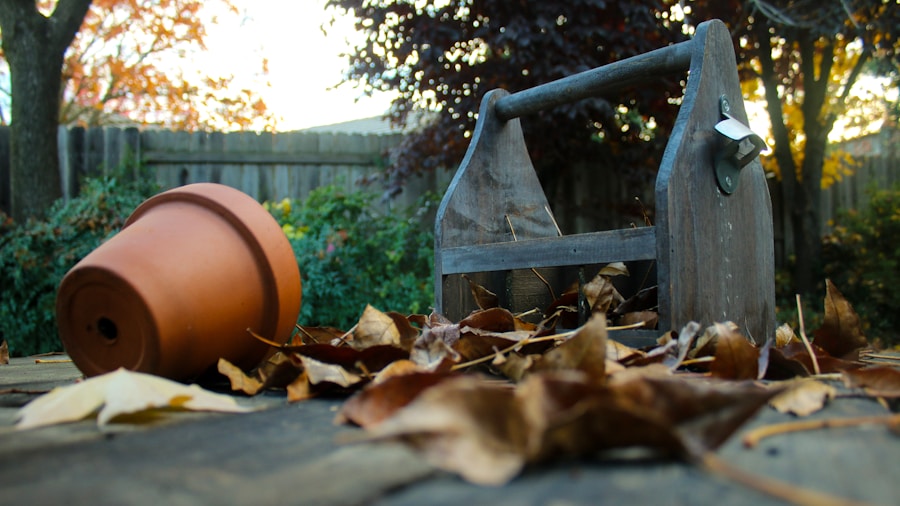As summer fades into autumn, the landscape undergoes a remarkable transformation. The vibrant greens of summer give way to a rich tapestry of reds, oranges, and yellows, as trees shed their leaves in preparation for the colder months ahead. This seasonal shift is not merely aesthetic; it signals a time of transition in the gardening world.
The days grow shorter, temperatures drop, and the air becomes crisp, prompting both plants and gardeners to adapt to the changing environment. Understanding these changes is crucial for anyone looking to maintain a thriving garden through the fall and into winter. The fall season brings with it a unique set of challenges and opportunities for gardeners.
With the onset of cooler weather, many plants begin to enter a state of dormancy, conserving energy for the harsher conditions that lie ahead. This period of rest is essential for perennial plants, which will emerge stronger in the spring. However, it also means that gardeners must be proactive in their care routines.
Recognizing the signs of seasonal change allows gardeners to make informed decisions about what to plant, how to protect existing flora, and when to prepare for winter’s arrival.
Key Takeaways
- Fall season brings changes in temperature and daylight hours, affecting plant growth and maintenance needs
- Clear out summer debris and prepare soil by removing weeds and adding compost or mulch
- Plant fall vegetables like kale and carrots, and flowers like mums and pansies for a colorful garden
- Protect plants from frost and cold temperatures by covering them with blankets or bringing them indoors
- Mulch and compost to insulate soil and provide nutrients for winter, and prune and divide perennials for healthy growth next year
Cleaning up summer debris and preparing the soil
As autumn approaches, one of the first tasks for gardeners is to clean up the remnants of summer. This involves removing spent plants, fallen leaves, and any other debris that may have accumulated over the warmer months. Not only does this cleanup create a more aesthetically pleasing garden space, but it also helps prevent pests and diseases from overwintering in the soil.
By clearing away old plant material, gardeners can reduce the risk of fungal infections and other issues that could threaten their garden’s health in the coming seasons. Once the garden is cleared, attention turns to preparing the soil for fall planting. This process often includes tilling or turning over the soil to aerate it and improve drainage.
Adding organic matter, such as compost or well-rotted manure, enriches the soil with essential nutrients that will support new plant growth. Testing the soil’s pH can also be beneficial at this stage; adjusting it as necessary ensures that plants will have optimal conditions for growth. By taking these steps, gardeners set a solid foundation for their fall crops and flowers.
Planting fall vegetables and flowers

With the soil prepared and cleaned, it is time for gardeners to consider what to plant during the fall season. Many vegetables thrive in cooler temperatures, making autumn an ideal time for crops such as kale, spinach, and Brussels sprouts. These hardy plants not only tolerate frost but often taste sweeter after exposure to cold weather.
By planting these vegetables in late summer or early fall, gardeners can enjoy a bountiful harvest well into winter. In addition to vegetables, fall is also an excellent time to plant certain flowers that can add color and vibrancy to the garden as it transitions into winter. Mums, pansies, and ornamental kale are popular choices that can withstand cooler temperatures while providing visual interest.
Planting these flowers in early fall allows them to establish roots before winter sets in, ensuring they will bloom beautifully when spring arrives. By diversifying their plant selections during this season, gardeners can create a dynamic landscape that remains engaging throughout the colder months.
Protecting plants from frost and cold temperatures
| Method | Effectiveness | Cost |
|---|---|---|
| Covering plants with frost cloth | High | Low |
| Using heat lamps | Medium | Medium |
| Applying mulch around plants | Low | Low |
| Spraying plants with anti-transpirant | Low | Medium |
As temperatures continue to drop, protecting plants from frost becomes a critical concern for gardeners. Frost can cause significant damage to tender plants, leading to wilting or even death if not addressed promptly. One effective strategy is to cover vulnerable plants with frost cloths or blankets during particularly cold nights.
These protective coverings trap heat and shield plants from icy winds, providing a buffer against harsh conditions. In addition to physical coverings, gardeners can also employ other techniques to safeguard their plants. Mulching around the base of plants helps insulate roots from freezing temperatures while retaining moisture in the soil.
Additionally, grouping potted plants together can create a microclimate that offers some protection from cold winds. By being proactive in their frost protection efforts, gardeners can ensure that their plants survive the winter months and emerge healthy come spring.
Mulching and composting for winter preparation
As fall progresses, mulching becomes an essential practice for preparing gardens for winter. A thick layer of mulch not only helps regulate soil temperature but also prevents erosion and suppresses weed growth during the colder months. Organic mulches, such as straw or shredded leaves, break down over time, enriching the soil with nutrients as they decompose.
This natural process contributes to healthier soil structure and promotes beneficial microbial activity. Composting is another vital aspect of winter preparation that complements mulching efforts. Gardeners can collect kitchen scraps and yard waste throughout the fall season to create nutrient-rich compost that will benefit their gardens in the spring.
By maintaining a compost pile or bin, they can recycle organic materials while reducing waste. The resulting compost serves as an excellent amendment for soil, enhancing its fertility and structure when it is time to plant again. Together, mulching and composting create a sustainable approach to gardening that supports long-term health and productivity.
Pruning and dividing perennials

As autumn settles in, it is also an opportune time for pruning and dividing perennials. Pruning helps maintain plant health by removing dead or diseased branches while encouraging new growth in the following season. For many perennials, cutting back foliage after it has died back allows energy to be redirected toward root development rather than maintaining unnecessary top growth.
This practice not only improves aesthetics but also enhances overall plant vigor. Dividing perennials is another beneficial task that can be performed in the fall. Over time, many perennial plants become overcrowded, leading to diminished blooms and overall health.
By carefully digging up clumps of these plants and separating them into smaller sections, gardeners can rejuvenate their perennials while creating new plants for other areas of their garden or sharing with friends. This process not only promotes healthier growth but also allows gardeners to expand their garden without purchasing new plants.
Preparing garden tools and equipment for storage
As gardening activities wind down with the arrival of colder weather, it is essential for gardeners to prepare their tools and equipment for storage. Proper maintenance ensures that tools remain in good condition and are ready for use when spring arrives again. Cleaning tools thoroughly after each use helps remove dirt and debris that can lead to rust or deterioration over time.
A simple wash with soap and water followed by drying can significantly extend the life of gardening implements. In addition to cleaning, sharpening blades on tools such as pruners and hoes is crucial for maintaining efficiency in future gardening tasks. Dull blades can make work more laborious and less effective.
Once cleaned and sharpened, tools should be stored in a dry location to prevent moisture-related damage. Organizing tools in a designated area not only makes them easier to find but also protects them from unnecessary wear and tear during storage.
Planning for next year’s garden
As fall draws to a close, many gardeners begin to turn their thoughts toward next year’s garden plans. This reflective period provides an opportunity to assess what worked well during the past growing season and what could be improved upon in the future. Keeping a gardening journal can be invaluable during this process; noting successes and challenges allows gardeners to make informed decisions about crop rotation, plant selection, and overall garden design.
In addition to reflecting on past experiences, planning for next year’s garden involves researching new varieties of plants or innovative gardening techniques that may enhance productivity or sustainability. Whether considering companion planting strategies or exploring vertical gardening options, there are always new ideas to incorporate into future plans. By taking the time to thoughtfully plan ahead during the fall season, gardeners set themselves up for success when spring arrives once again, ready to cultivate a flourishing garden filled with life and beauty.
If you’re looking to enhance your outdoor space this fall, you may want to consider integrating advanced waterproofing tactics into your garden design. This article on smart home solutions provides valuable insights on how to protect your garden from the elements and ensure it thrives throughout the autumn season. By implementing these strategies, you can create a beautiful and functional outdoor space that will withstand the changing weather conditions.
FAQs
What are some essential autumn gardening tips?
Some essential autumn gardening tips include cleaning up the garden by removing dead plants, mulching to protect plants from the cold, planting bulbs for spring blooms, and pruning trees and shrubs.
Why is it important to clean up the garden in autumn?
Cleaning up the garden in autumn is important to remove dead plants and debris that can harbor pests and diseases. It also helps prepare the garden for the winter months.
What is the significance of mulching in autumn gardening?
Mulching in autumn helps to insulate the soil, retain moisture, and protect plant roots from freezing temperatures. It also helps to suppress weed growth and improve the overall health of the garden.
When is the best time to plant bulbs for spring blooms?
The best time to plant bulbs for spring blooms is in the autumn, before the ground freezes. This allows the bulbs to establish roots before the winter and bloom in the spring.
Why is pruning trees and shrubs important in autumn?
Pruning trees and shrubs in autumn helps to remove dead or diseased branches, improve the overall shape of the plants, and promote healthy growth in the following season. It also helps to prevent damage from winter storms.





